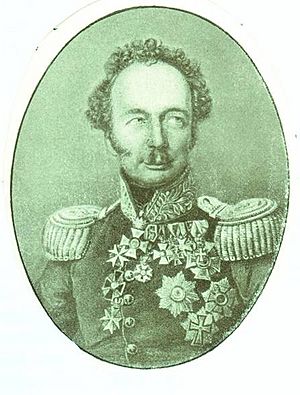Friedrich Wilhelm von Bismarck facts for kids
Friedrich Wilhelm Graf von Bismarck (born July 28, 1783 – died June 18, 1860) was a German military leader, a diplomat, and a writer. He reached the high rank of lieutenant general. He wrote many important books about military history and politics, and he greatly admired Napoleon.
Contents
Early Life and Military Career
Friedrich Wilhelm von Bismarck was born in Windheim, Westphalia. His family, the House of Bismarck, was a well-known noble family. In 1796, when he was just 13, he joined the military as a cornet in the Hanoverian Army.
In 1803, he moved to the army of Nassau. The next year, in 1804, he joined the King's German Legion. With this group, he fought in northern Germany in 1805. He had to leave in 1807 because of a duel. After that, he became a cavalry captain in the Army of Württemberg.
On September 7, 1807, he married Augusta Amalia. She was a daughter of Frederick Augustus, Duke of Nassau.
Fighting with Napoleon
In 1809, Württemberg was an ally of Napoleon. Friedrich Wilhelm von Bismarck showed great bravery under the command of André Masséna. He was especially noted for his actions at the battle near Riedau on May 1, 1809.
In 1812, he took part in all the battles fought by Michel Ney's army group. He commanded the 1st Chevau-Léger Regiment in several important battles. These included the Battle of Bautzen and battles near Seifersdorf on May 26, 1813, and Dennewitz on September 6, 1813. He was eventually captured at the famous battle of Leipzig.
When Württemberg changed sides to fight against Napoleon, von Bismarck joined the general staff. In 1815, he was made commander-in-chief of the Crown Provinces. The next year, he was given the title of Graf (count). He was also promoted to oberst (colonel) and flugeladjutant.
Later Career and Family
After William I of Württemberg became king, Friedrich Wilhelm von Bismarck was put in charge of reorganizing the army's cavalry. He became a major general in 1819. He also became a member of the Kammer der Standesherren, which was like a house of lords in Württemberg.
In 1820, he became a special envoy to the court in Karlsruhe. Five years later, he became an ambassador. He represented Württemberg in the Kingdom of Prussia, the Kingdom of Saxony, and the Kingdom of Hanover. He was promoted to lieutenant general in 1830.
He retired in 1848. On April 5, 1848, he married Amalie Julie Thibaut. They had two children together:
- August Wilhelm Julius Graf von Bismarck (1849–1920). He became a hussar officer and a horse breeder. He died without children.
- Clara Gräfin von Bismarck (1851–1946). She later married a Swiss general named Ulrich Wille.
Friedrich Wilhelm von Bismarck fully gave up his seat in the Estates in 1853 due to health reasons. He then retired to Konstanz.
Honours
Friedrich Wilhelm von Bismarck received many awards and honours for his military service and diplomatic work. These included:
 French Empire: Legion of Honour, 1809 – personally given to him by Napoleon
French Empire: Legion of Honour, 1809 – personally given to him by Napoleon Württemberg:
Württemberg:
- Commander of the Military Merit Order, September 7, 1813
- Grand Cross of the Friedrich Order, 1830
- Grand Cross of the Württemberg Crown, 1835
 Russian Empire:
Russian Empire:
- Knight of St. George, 4th Class, July 13, 1815
- Order of Saint Anna
 Kingdom of Bavaria: Knight of St. Hubert, 1822
Kingdom of Bavaria: Knight of St. Hubert, 1822 Denmark: Grand Cross of the Dannebrog, June 13, 1828
Denmark: Grand Cross of the Dannebrog, June 13, 1828 Baden:
Baden:
- Grand Cross of the House Order of Fidelity, 1833
- Grand Cross of the Zähringer Lion, 1833
 Austrian Empire:
Austrian Empire:
- Knight of the Iron Crown, 3rd Class
- Knight of the Imperial Order of Leopold
 Kingdom of Prussia:
Kingdom of Prussia:
- Order of the Red Eagle
- Knight of the Johanniter Order
 Electorate of Hesse: Knight of the Pour la Vertu Militaire
Electorate of Hesse: Knight of the Pour la Vertu Militaire
Writings
Friedrich Wilhelm von Bismarck was also a military writer. He wrote several books about cavalry tactics and military history:
- Felddienst der Reyterei (Cavalry Field Service). Karlsruhe 1820.
- System der Reuterei (Cavalry System). Berlin & Posen 1822.
- Schützensystem der Reuterei (Cavalry Skirmishing System). Stuttgart 1824.
- Vorlesungen über die Taktik der Reuterei. Elemente der Bewegungskunst eines Reuter-Regiments (Lectures on Cavalry Tactics. Elements of Movement Art for a Cavalry Regiment). Karlsruhe 1819, 2nd edition 1826.
- Reuterbibliothek (Cavalry Library) (6 volumes). Karlsruhe 1825–1831.
- Ideentaktik der Reuterei (Idea Tactics of Cavalry). Karlsruhe 1829.
- Aufzeichnungen (Notes). Karlsruhe 1847.


